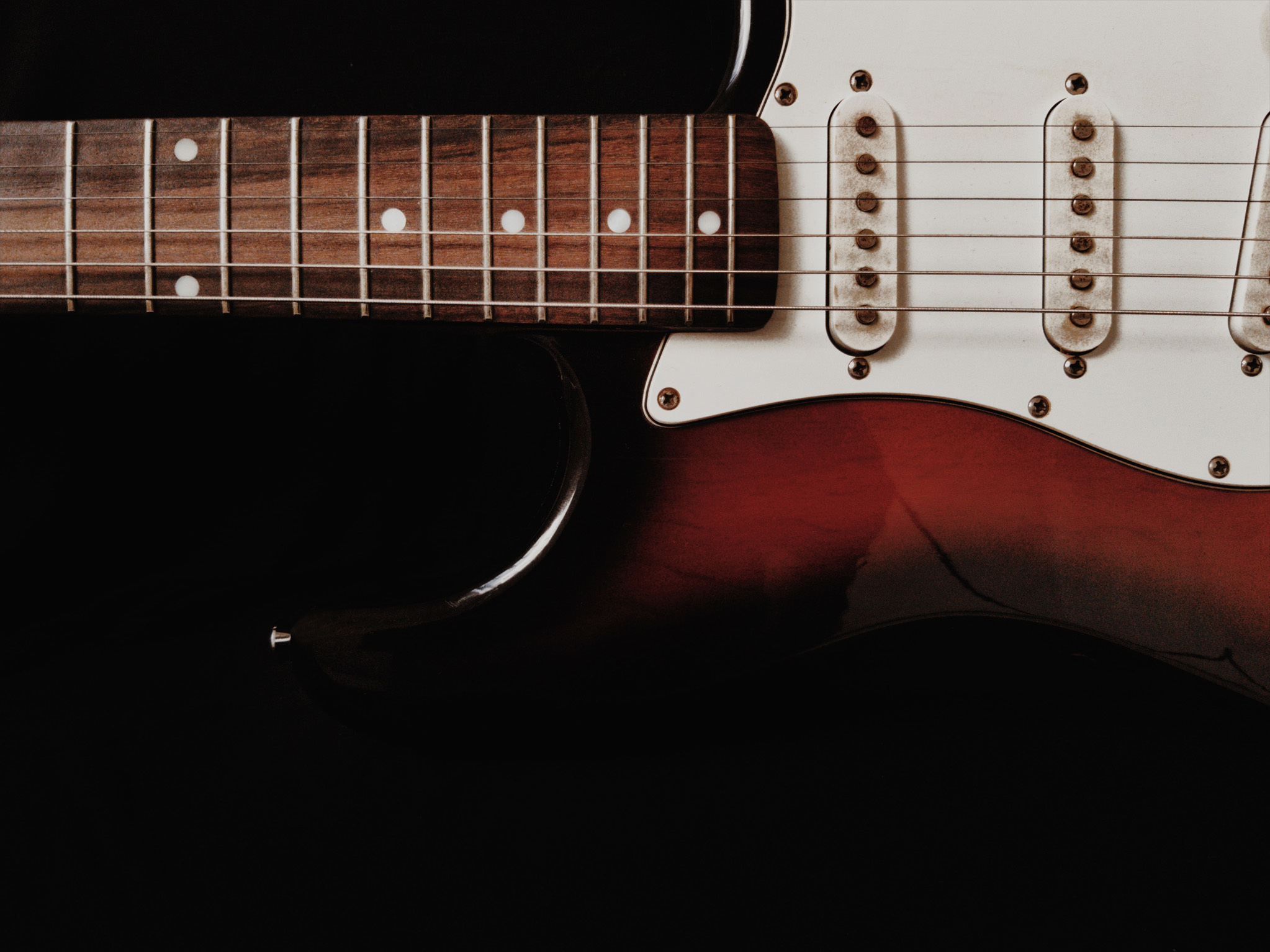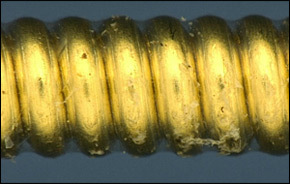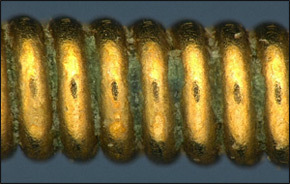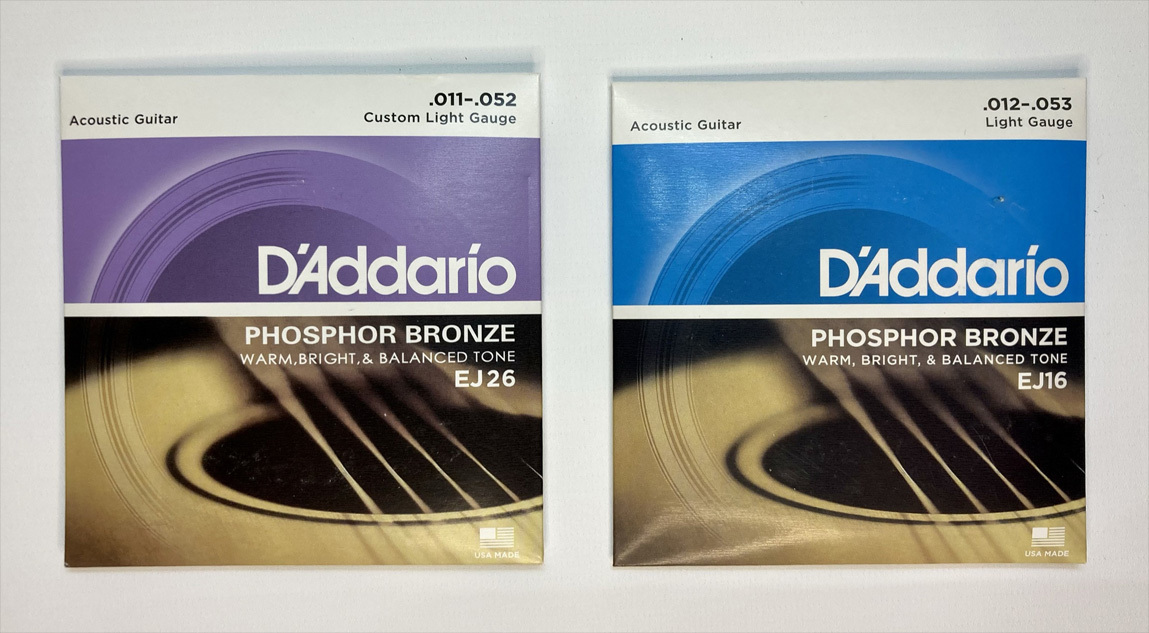選擇合適自己的結他弦的重要性:改變結他弦就是改變音色最低成本的方法
每一位結他手都有自己獨特的音色
音色主要由三項因素互相影響而產生:結他本身、結他弦 和結他手彈奏技巧
所以理論上只要換一換結他弦,你的音色就有所改變。
首先我們認清三種常見的結他:
1. 木結他(Acoustic Guitar) 2. 電結他(Electric Guitar) 3. 古典結他(Classical Guitar)
不同的結他種類都有他們專屬的弦,每一種弦所挑選的素材和製成方法都是為了搭配該結他的發聲原理,彼此之間並不通用的,也建議不要嘗試喔。
如果在古典結他裝了木結他弦,這會傷害到你的結他,甚至因此而毀掉。
我們會先探討鋼弦,然後到尼龍弦。
鋼弦(Steel Stings)
木結他弦與電結他弦都可以通稱為鋼弦,不過它們有著不同纏繞的質料及外觀上的分別,而且低音弦有著不同的外衣,弦芯才是鋼弦。
鋼弦的基本結構:
結他弦實際上並沒有很多東西,但所有單獨的組件都聚集在一起,為您的聲音創造了命脈。穿過弦中間的是一根金屬芯線。
芯線固定在黃銅套圈(通常稱為“Ball End”)上,黃銅套圈通常將弦固定在琴橋上。金屬芯線周圍是另一根圓形繞線,是手指壓在指板上的部分。
我們會分別會從鋼弦的質料、弦徑、弦芯、纏繞技術講解。

質料
常見的民謠/木結他弦
黃銅(青銅) 80/20 Bronze、85/15 Bronze
黃銅弦的外表偏黃,以銅:錫比例80/20或是85/15所組成的金屬線,纏繞著高碳鋼弦而形成。音色偏亮,穿透力強。
多數的新結他都使用這種弦,以0.012或是0.011的粗度居多。
80/20是最常見的,而85/15比例的弦較少廠商有出,以D’Addario最具代表性。音色介於80/20與紅銅弦之間,外觀大至與80/20相同。
紅銅/磷青銅 Phosphor Bronze
紅銅弦正名為磷青銅弦,外表偏紅,是由90%銅和10%錫 再加上少量的磷組成,纏繞在高碳鋼弦上。不少演奏家會使用這種琴弦,音色溫暖圓潤、相對清脆,使用期限相對黃銅較長一些。
絲銀 Silk & Steel
絲銀有著銀色的外衣,十分容易辨認。簡易的說是鋼弦、尼龍弦的混合體,以鍍銀的80/20 Bronze弦包覆絲綿尼龍線,中心是鋼弦。是相當好按的弦,軟度如電結他弦一般,適合初學者,但因為張力低,彈奏時幅度較大,不適合弦距低的琴。音量較小,但聲音清脆而且較柔和。

常見的電結他弦
鍍鎳鋼 Steel/Nickel-plated steel
最常見的電結他弦,結合不鏽鋼與純鎳。音色上達到明亮又溫暖的平衡。雖然壽命較短,但適合多種音樂風格,手感亦光滑舒適。
不鏽鋼 Stainless Steel
音色極為明亮和清脆,具有光滑的觸感及抗腐蝕性,深受彈奏Rock、Metal、Jazz及Fusion的樂手喜愛。
純鎳結他弦 Pure Nickel
音色相對比較暗並略為溫暖,適合演奏鄉村(Country)及靈魂(Soul)的樂手。
覆膜與鍍膜(Coating)
覆膜與鍍膜其實有著相同的作用,能夠讓弦阻絕接觸空氣而不會氧化、也增加弦的耐用性,但這種弦價格會偏高。
 有Coating
有Coating 沒有Coating
沒有Coating
弦徑(Gauge)
Gauge是標示弦徑的單位,常見的弦徑標示方法如:.011 ~ .052、10|48、或是11 – 52。代表結他弦粗細意思,第一弦是 0.011 ( inch ) ~ 第六弦是 0.052 ( inch )。所以這弦的Gauge就是11 – 52。

*特別注意*
第一點,較便宜的結他,不建議更換0.012 ( inch ) 以上的弦,因為鋼弦張力過大可能會扭曲琴頸!
第二點,若你結他彈奏的樂風需要降弦,例如:從標準的EADGBE調成DGCFAD或更低的音時,就可能要挑選.012或甚至是更粗的弦徑。
弦芯(Core)
六角弦芯Hex Core
六角弦芯設計,讓弦擁有強度及更穩定,能產生較大的張力,使弦的聲音更響亮,但因張力大令推弦更難。六角弦芯設計的音色明亮又溫暖,而且有更長的延音。
圓柱形弦芯Round Core
圓柱形弦芯是傳統的設計,圓芯設計可冢以讓音色更飽滿、更自然均勻。

(圖片來源: jazzguitartoday.com)
纏繞技術(Winding)
圓形纏繞Round Wound
迄今為止最普遍的繞弦方法,圓繞弦具有明顯的脊狀紋理,它們有不平整的纏繞觸感,往往會產生更多的噪音,而且指板會磨損。它們能夠產生更長的延音。
平滑纏繞(Flat wound)
1960 年代起開始使用的加工方式,平滑纏繞具有非常平滑的觸感,具有平坦、暗色調,對撥弦動態的響應較弱。這些結他弦深受爵士和藍調結他手的歡迎。
半圓纏繞(Half/Ground Wound)
半圓形弦的質地更光滑,音色更深,比圓形弦的攻擊力更小。

(圖片來源: seymourduncan.com)

尼龍弦(Nylon String)
一般古典結他所用的都是尼龍弦。但除了古典結他,烏克麗麗(Ukulele)及其他風格結他如佛拉門哥(Flamenco),都使用到尼龍弦。
當選擇尼龍弦時,主要考量有兩點「張力」及「質料」。
張力Tension
普遍分為高、中、低張力。
|
高張力
High Tension
|
中張力
Normal Tension
|
低張力
Low Tension
|
|
彈奏費力
|
手感適中
|
容易彈奏
|
|
聲音較亮麗
|
音色相對平均
|
聲音較溫和
|
|
音量較大
|
音量中等
|
音量較小
|
|
震幅小不易打弦
|
震幅中等較少打弦
|
震幅大易打弦
|
|
不易斷裂,韌性強
|
壽命較短
|
壽命最短,易斷裂
|

建議初學者選用中張力的弦(Normal Tension),手感與震幅都適中。
高張力或材質偏硬的弦(High Tension),會較適合演奏熱情奔放或現代高難度技巧的音樂,所需的音色可能是亮麗或穿透力強的結他弦。
中低張力或材質偏軟(Normal/Low Tension),適合想要演奏舒適慵懶的曲風或典雅高貴的古典音樂,音色可能需要高音清澈及低音溫暖。
質料
最早期的弦都使用到動物的內臟和纖維造成。現今的弦大部分都用尼龍而製成,在常見的古典結他,高音弦(1~3弦)由尼龍拉製成,而成低音弦(4~6弦)以絲棉尼龍線為線芯,外圍再纏繞金屬線所組成,所以外觀上高音弦和低音弦會不同,但實際上都是由尼龍線製成。
高音弦種類
|
質料/種類
|
|
|
傳統透明尼龍Nylon
|
音色溫暖、明亮,具穿透力。
|
|
碳纖維Carbon
|
比傳統尼龍弦更為明亮,有更強穿透性與力度,音色清澈。
|
|
鈦金屬Titanium
|
新材質高音弦,有光滑的觸感,更強力的高音,音色極為通透、清晰及雄厚。
|
低音弦種類
|
質料/種類
|
|
|
鍍銀銅錫合金Silver-plated Copper
|
80%銅、20%錫、外層鍍銀,音色溫暖而豐富。
|
|
銅鋅合金80/20 Bronze
|
80%銅、20%鋅,音色明亮,極具穿透性。
|
覆膜與拋光技術(Coated and Polished)
覆膜技術
低音弦在纏繞之前,先包一層細微的護膜。
覆膜技術能夠防止弦的氧化,並提升耐用性。一般可以延長四倍左右的壽命,但價格也會較高。
拋光技術
將低音弦打磨拋光,令弦表面更光滑,這樣可以減少左手移動把位時發出的雜音。
要如果選擇合適的結他弦呢?
可以從三個方向去考慮:1. 先決定弦徑/張力 2. 質料 3. 結他弦品牌和製弦技術(纏繞/覆膜/弦芯)
建議初學者都選擇一些最普遍和常見的結他弦,到日後才開始嘗試不同類型的弦。
其實很難指明那一種弦會絕對適合某一個音樂風格或某一類結他手。隨著你的彈奏習慣改變,你對弦的要求又會改變,而且相同的弦在不同的結他上會有不同的效果,所以鼓勵大家嘗試不同類型的弦並尋找最合適自己的。
如何換結他弦呢?
以下分別有兩段影片教大家如何換民謠/木結他弦及古典結他弦。
逆月音樂為大家提供不同類型結他弦,想了解更多可以到這裡。
作者: 呂卓翹 Jonathan Lui
___________________________________________________________________________________________________________________________________________________________________________
It’s vital to choose the right guitar strings: Changing guitar stings is the lowest cost way to improve your tone
Every guitarist has his own unique tone
The timbre is mainly produced by the mutual influence of three factors: the guitar itself, the guitar string and the guitarist playing skills.
So in theory, as long as you change the guitar string, your tone will change.
First of all, we need to recognize three common guitars:
- Acoustic Guitar 2. Electric Guitar 3. Classical Guitar
Different guitar types have their own strings. The materials and methods of each type of string are chosen to match the sounding principle of the guitar. They are not common to each other, and it is recommended not to try it.
If you install wooden guitar strings in a classical guitar, it will hurt your guitar or even ruin it.
We will discuss steel strings first and then nylon strings.
Steel Stings
Both acoustic guitar strings and electric guitar strings can be called steel strings, but they have different winding materials and appearance, and the bass strings have different coats, only the core of the string is the steel string.
The basic structure of steel string:
Guitar strings don’t actually have a lot of things, but all the individual components come together to create the lifeblood of your sound. Passing through the middle of the string is a metal core wire.
The core wire is fixed to a brass ferrule (often called "Ball End"), which usually fixes the string to the bridge. Around the metal core is another round winding, which is the part of the finger pressed against the fingerboard.

Common folk songs/wood guitar strings
80/20 Bronze、85/15 Bronze
The appearance of the brass string is yellowish. It is formed by winding a high-carbon steel string with a metal wire composed of a copper: tin ratio of 80/20 or 85/15. The tone is brighter and has strong penetrating power.
Most new guitars use this string, mostly with a thickness of 0.012 or 0.011.
80/20 is the most common, while 85/15 strings are produced by fewer manufacturers, with D’Addario being the most representative. The tone is between 80/20 and red copper strings, and the appearance is similar to 80/20.
Phosphor Bronze
The phosphor bronze string has a reddish appearance. It is composed of 90% copper and 10% tin plus a small amount of phosphorus, and is wound on a high-carbon steel string. Many performers will use this kind of strings, the sound is warm and round, relatively crisp, and the life time of this string is longer than that of 80/20 Bronze.
Silk & Steel
Silk & Steel has a silver coat, which is very easy to identify. To put it simply, it is a mixture of steel strings and nylon strings. The silver-plated 80/20 Bronze string is covered with silk and nylon strings, with a steel string in the center. It is a very easy-to-pressas soft as an electric guitar string. It is suitable for beginners. However, because of the low tension, the vibration amplitude of the string is huge . The volume is low, but the sound is crisp and softer.

Common electric guitar strings
Steel/Nickel-plated steel
The most common electric guitar string combines stainless steel and pure nickel. Tones reach a bright and warm balance. Although it has a short lifetime, it is suitable for a variety of music styles and feels smooth and comfortable.
Stainless Steel
The sound is extremely bright and crisp, with smooth touch and corrosion resistance, which is very popular among musicians who play Rock, Metal, Jazz and Fusion.
Pure Nickel
The tone is relatively dark and slightly warm, suitable for musicians who play Country and Soul.
Coating
The coating, which can prevent the string from contacting the air without being oxidized, and also increase the durability of the string, but the price of this string will be higher.
 Coating
Coating No Coating
No Coating
Gauge
Gauge is a unit to indicate the string diameter. Common methods for indicating the chord diameter are: .011 ~ .052, 11|52, or 11-52. Represents the thickness of the guitar string, the first string is 0.011 (inch) ~ the sixth string is 0.052 (inch). So the Gauge of this string is 11-52.

*Pay Attention*
The first point is that for cheaper guitars, it is not recommended to replace strings above 0.012 (inch), because excessive tension on the steel strings may distort the neck!
The second point is that if the guitar style you play needs to be lowered, for example, when tuned from standard EADGBE to DGCFAD or lower, you may have to choose .012 or even a thicker string diameter.
Core
Hex Core
The Hex string core design gives the string more strength and stability, can generate greater tension, and make the string sound louder, but it is more difficult to bend due to the high tension. The sound of the hexagonal core design is bright and warm, and has a longer sustain.
Round Core
The Round string core is a traditional design, and the round core design can be used to make the sound fuller, more natural and even.

(Picture Source: jazzguitartoday.com)
Winding
Round Wound
By far the most common method of winding strings, round strings have obvious ridge textures, they have uneven winding touch, tend to produce more noise, and the fingerboard will wear. But they can produce longer sustain.
Flat wound
This method used since the 1960s, smooth winding has a very smooth touch, flat, dark tone, and weak response to the dynamics of plucking strings. These guitar strings are popular with jazz and blues guitarists.
Half/Ground Wound
The texture of the semi-circular string is smoother, the tone is deeper, and the attack power is less than that of the round string.

(Picture Source: seymourduncan.com)

Nylon String
Generally, nylon strings are used for classical guitars. But in addition to classical guitars, Ukulele and other styles of guitars, such as Flamenco, all use nylon strings.
When choosing nylon strings, there are two main considerations: "tension" and "material".
Tension
Generally divided into high, medium and low tension.
|
High Tension
|
Normal Tension
|
Low Tension
|
|
Play effort
|
Feel moderate
|
Easy to play
|
|
The sound is brighter
|
Relatively average timbre
|
Softer and warmer sound
|
|
Louder
|
Medium volume
|
Low volume
|
|
Small vibration amplitude
|
Medium amplitude
|
Large vibration amplitude
|
|
Not easy to break, strong toughness
|
Shorter life
|
Shortest life, easy to break
|

It is recommended for beginners to choose a normal tension string, which has a moderate feel and amplitude.
Strings with high tension or hard material (High Tension) are more suitable for playing passionate and unrestrained or modern music with difficult techniques. The required sound may be bright or penetrating guitar strings.
Medium and low tension or soft material (Normal/Low Tension), suitable for playing comfortable and lazy style or elegant and noble classical music, the tone may need clear high pitch and warm bass.
Material
In earlier time, strings were made using animal internal organs and fibers. Nowadays most of the strings are made of nylon. In the common classical guitar, the treble strings (1~3 strings) are drawn from nylon, and the bass strings (4~6 strings) are made of silk cotton nylon thread, while the core is composed of a metal wire wound around the outside, so the treble string and the bass string will be different in appearance, but they are actually made of nylon wire.
Types of Treble Strings
|
Material/Type
|
|
|
Nylon
|
The tone is warm, bright and penetrating.
|
|
Carbon
|
It is brighter than traditional nylon strings, has stronger penetrability and strength, and has a clear tone.
|
|
Titanium
|
The new material treble string has a smooth touch, a stronger treble, and the sound is extremely transparent, clear and strong.
|
Types of Bass Strings
|
Material/Type
|
|
|
Silver-plated Copper
|
80% copper, 20% tin, silver-plated outer layer, warm and rich tone.
|
|
80/20 Bronze
|
80% copper, 20% zinc, bright tone, very penetrating.
|
Coated and Polished
Coated
Before the bass strings are wound, they are covered with a fine protective coated.
Laminating technology can prevent oxidation of the strings and improve durability. Generally, the life span can be extended by about four times, but the price will be higher.
Polished
Polish the bass strings to make the surface of the strings smoother, which can reduce the noise when the left hand moves the handle.
How to choose the right guitar string?
It can be considered from three directions: 1. First determine the string diameter/tension 2. Material 3. Guitar string brand and string making technology (winding/coating/string core)
It is recommended that beginners choose some of the most common brands and common guitar strings, and only start to try different types of strings in the future.
In fact, it is difficult to specify which kind of string is absolutely suitable for a certain music style or a certain type of guitarist. As your playing habits change, your string requirements will change, and the same string will have different effects on different guitars, so everyone is encouraged to try different types of strings and find the most suitable one.
How to change the guitar string?
Above this English section, there're two videos respectively teach you how to change acoustic guitar strings and classical guitar strings.
Six Months Rebellion provide different types of guitar strings. To know more, you can click Here.
Author: Jonathan Lui









